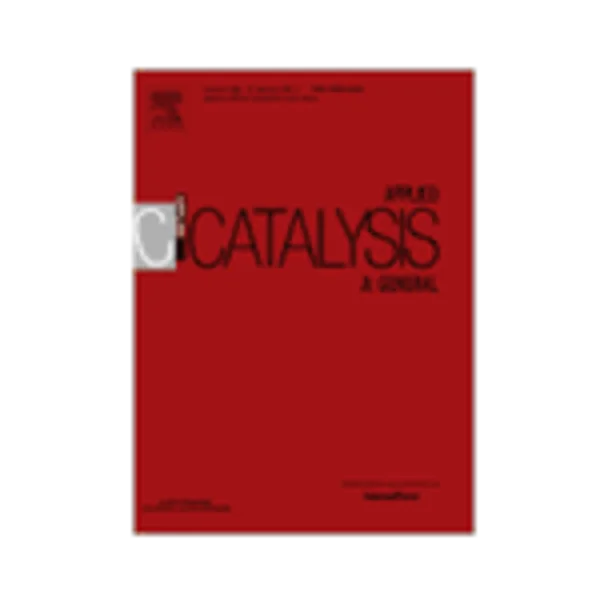-
direct synthesis of dme from syngas on hybrid cuznal/zsm-5 catalysts: new insights into the role of zeolite acidity
جزئیات بیشتر مقاله- تاریخ ارائه: 1392/07/24
- تاریخ انتشار در تی پی بین: 1392/07/24
- تعداد بازدید: 953
- تعداد پرسش و پاسخ ها: 0
- شماره تماس دبیرخانه رویداد: -
a commercial hzsm-5 zeolite (si/al = 16) was submitted to mild acid treatment and partial exchange of h+by na+ and co2+ cations in order to produce samples with different amounts and strengths of brønsted and lewis acid sites. the acid properties of the zeolites were determined by both ftir of adsorbed pyridine and nh3-tpd. then, hybrid catalysts comprising a cuo/zno/al2o3 (cza) methanol synthesis catalyst and the original and treated zeolites were prepared in order to analyze the impact of the zeolite acidity in the efficiency of the hybrids for the direct syngas-to-dme process. independent methanol dehydration experiments on the bare zeolites and syngas-to-dme runs under methanol dehydration-controlled conditions were performed using hybrids with low zeolite concentration (cza:zeolite mass ratio of 10:1) prepared by mixing the pre-pelletized cza and zeolite components. the results revealed that both strong brønsted and efal-related strong lewis acid sites are the likely zeolite active sites for methanol dehydration at the typical syngas-to-dme temperature of 260 °c. interestingly, we have found that different conclusions regarding the effect of zeolite acidity may be reached depending on the specific method used for preparing the hybrid catalysts when the overall syngas-to-dme process becomes controlled by the methanol synthesis rate on the cu-based catalyst (i.e. using hybrids with a cza:zeolite mass ratio of 2:1, that is, with an “excess” of acid sites). thus, for hybrids prepared by mixing the pre-pelletized components, the same co conversion and product selectivity (with values approaching those predicted by the thermodynamic equilibrium at the studied conditions) with no signs of deactivation during at least 50 h on stream was attained irrespective of the zeolite acidity. by contrast, significant differences in catalyst stability were found for hybrids prepared by grinding the component powders prior to pelletizing. this fact points towards the occurrence of detrimental interactions between the cza and zeolite components during the grinding preparation stage. the kind and extent of such detrimental interactions are tightly related to the properties (i.e. acidity, chemical composition) of the zsm-5 zeolite.
مقالات جدیدترین رویدادها
-
استفاده از تحلیل اهمیت-عملکرد در ارائه الگوی مدیریت خلاقیت سازمانی و ارائه راهکار جهت بهبود
-
بررسی تاثیر ارزش وجوه نقد مازاد بر ساختار سرمایه شرکت های پذیرفته شده در بورس اوراق بهادار تهران
-
بررسی تأثیر سطح افشای ریسک بر قرارداد بدهی شرکت های پذیرفته شده در بورس اوراق بهادار تهران
-
بررسی تأثیر رتبه بندی اعتباری مبتنی بر مدل امتیاز بازار نوظهور بر نقد شوندگی سهام با تأکید بر خصوصی سازی شرکت ها
-
تأثیر آمیخته بازاریابی پوشاک ایرانی بر تصویر ذهنی مشتری پوشاک ایرانی (هاکوپیان)
-
مقایسه تاثیر انواع الیاف بر مشخصات بتن
-
تحلیل دینامیکی پل های مورب با سخت کننده های طولی تحت بارهای متحرک به روش نوار محدود به منظور تعیین ضرایب تقویت دینامیکی
-
گزارش 1 مورد شوانوما با تظاهر توده زبانی
-
blind bolted moment connection to unfilled hollow section columns using extended t-stub with back face support
-
effects of y2o3 nanoparticles on growth behaviors of cu6sn5 grains in soldering reaction
مقالات جدیدترین ژورنال ها
-
مدیریت و بررسی افسردگی دانش آموزان دختر مقطع متوسطه دوم در دروان کرونا در شهرستان دزفول
-
مدیریت و بررسی خرد سیاسی در اندیشه ی فردوسی در ادب ایران
-
واکاوی و مدیریت توصیفی قلمدان(جاکلیدی)ضریح در موزه آستان قدس رضوی
-
بررسی تاثیر خلاقیت، دانش و انگیزه کارکنان بر پیشنهادات نوآورانه کارکنان ( مورد مطالعه: هتل های 3 و 4 ستاره استان کرمان)
-
بررسی تاثیر کیفیت سیستم های اطلاعاتی بر تصمیم گیری موفق در شرکتهای تولیدی استان اصفهان (مورد مطالعه: مدیران شرکتهای تولیدی استان اصفهان)
-
محدودیت فروش کوتاه مدت و خطر سقوط قیمت سهام با تاکید بر کارایی سرمایه گذاری
-
طراحی الگوی فرایند دانش آفرینی در دانشگاه بر اساس رویکرد آمیخته
-
بررسی اثر اقتصاد سیاسی پشت سر استقلال بانک مرکزی
-
خسارت ناشی از تأخیر در تحویل کالا و خسارات معنوی و اقتصادی در خصوص حمل و نقل دریایی
-
ارتباط بین استقرار مدیریت دانش و توانمندسازی با عملکرد شغلی کارکنان




سوال خود را در مورد این مقاله مطرح نمایید :